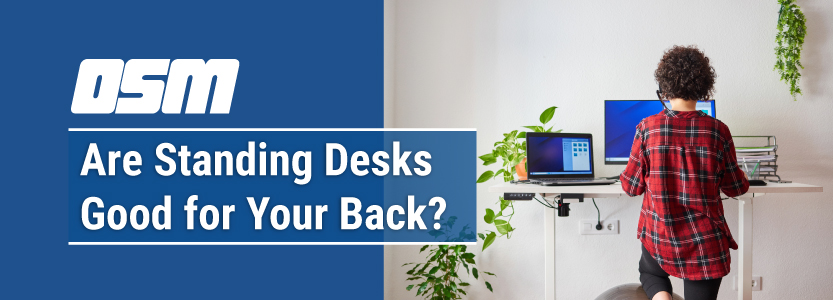Are Standing Desks Good for Your Back?
Article featured on Summit Orthopedics
Standing desks promise many benefits, including better overall health and less back pain. Research is ongoing into what, if any, benefits a standing desk might actually have, but if you’re used to sitting for long hours and staring at a computer each day, you know how tough all that sitting can be on your back and neck. Can a standing desk help?
The connections between sitting and back pain
One reason sitting for long periods of time can cause backaches is that it puts more pressure on the discs that cushion the spine’s bony vertebrae. Sitting for a long time can also cause muscles in the back to get stiff, creating soreness. If you’re sitting with poor posture, that can make the effects worse. Slouching can put more stress on the spinal ligaments and result in increased pressure on some parts of the spine. Standing desks seek to solve these problems.
Why might it be better to stand at a standing desk?
If your work requires you to be on a computer for most or all of your workday, a standing desk gives you a way to do that work while standing. Here are some potential benefits of standing more during the day:
- Standing can help with your posture (if your slouching is just a habit and is not caused by a larger problem with your spine).
- Standing may reduce back pain over time.
- Standing burns a few more calories per hour than sitting does.
- Some people find standing boosts their productivity (although this is not true for everyone).
Note Some people — those with vascular problems or who are at increased risk of swelling in their lower limbs — might have increased health risks from a standing desk. Talk with your healthcare provider before choosing to try a standing desk.
How can I get started with a standing desk?
- The most important thing to do is to take it slow. Don’t expect to go from 8-plus hours of sitting to 8-plus hours of standing right away. Build up your stamina gradually.
- Be mindful of the increased pressure on your feet and ankles. For example, you may want to wear supportive shoes to help prevent foot soreness. Anti-fatigue mats can also help.
- Take breaks to walk and move. This is also true if you’re at a sitting desk, but just because you’re standing doesn’t mean movement stops being beneficial. Move around to prevent stiffness and soreness.
The Orthopedic & Sports Medicine Center of Oregon is an award-winning, board-certified orthopedic group located in downtown Portland Oregon. We utilize both surgical and nonsurgical means to treat musculoskeletal trauma, spine diseases, foot and ankle conditions, sports injuries, degenerative diseases, infections, tumors and congenital disorders.
Our mission is to return our patients back to pain-free mobility and full strength as quickly and painlessly as possible using both surgical and non-surgical orthopedic procedures.
Our expert physicians provide leading-edge, comprehensive care in the diagnosis and treatment of orthopedic conditions, including total joint replacement and sports medicine. We apply the latest state-of-the-art techniques in order to return our patients to their active lifestyle.
If you’re looking for compassionate, expert orthopedic and podiatric surgeons in Portland Oregon, contact OSM today.
Phone:
Address
17355 Lower Boones Ferry Rd Suite 100A
Lake Oswego, OR 97035
Hours
Monday–Friday
8:00am – 4:30pm



